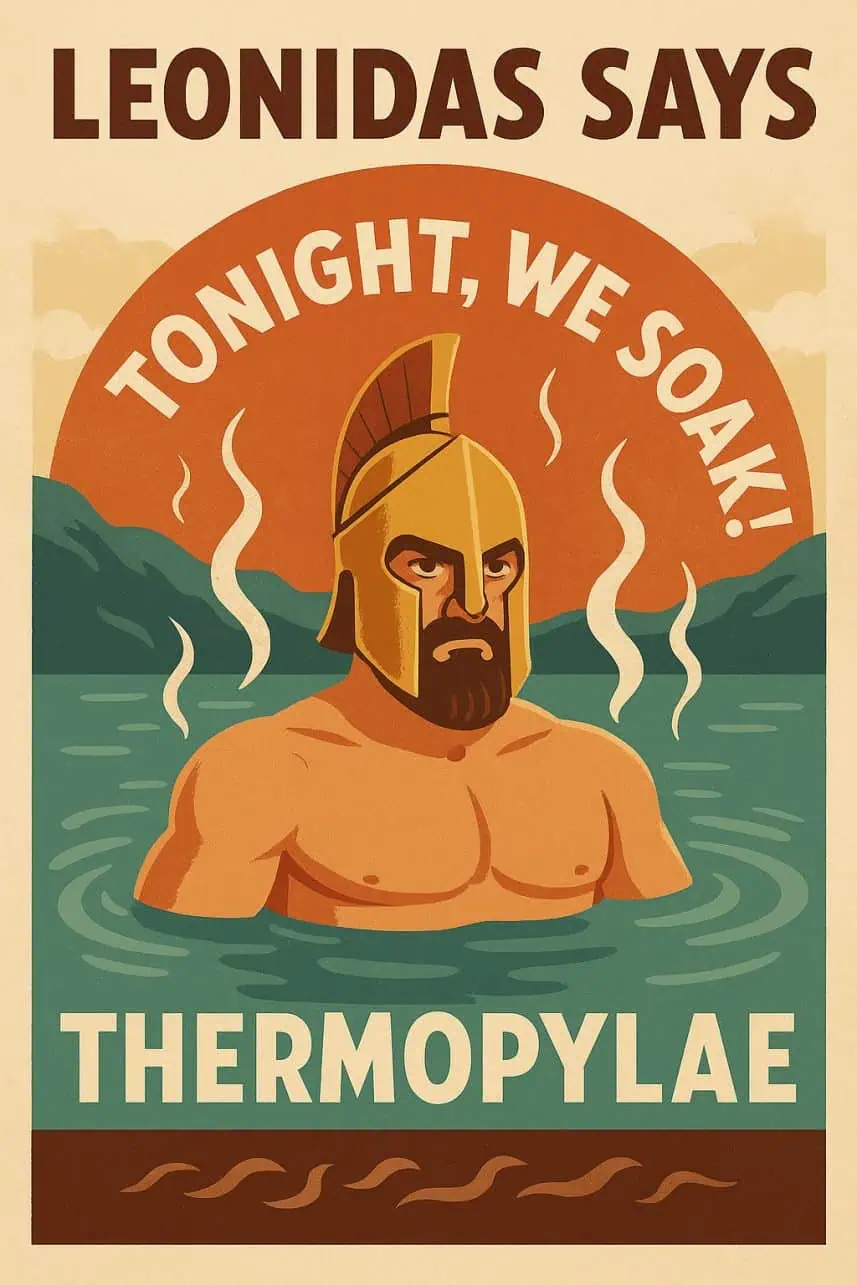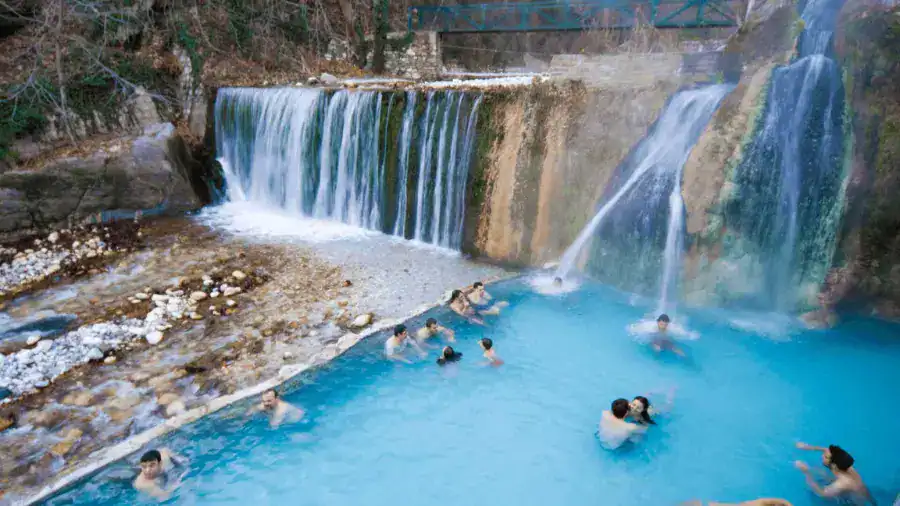The first light of dawn weaves into the low-lying mist, turning it gold. Steam curls lazily above the water, blurring the lines between the banks and grassy land. Wade in carefully—there are secrets from another age yet to uncover before you can relax.
In the distance, the Leonidas monument stands guard, looming about as large as he should—stern and solitary against the rising sun. Faint chatter, a few laughs, a few curses. These are the early risers, mostly locals, lowering themselves into the milky pools, fumes or no fumes. Cars on the nearby highway hum in the distance, but the scene still feels timeless, unspoiled by the modern buzz.
The Thermopylae hot springs aren’t a myth, but a place you can actually visit—and for free.
Travelers describe it as surreal: a steaming roadside pool framed by mountains and layers of history. There are no ticket booths, no fancy facilities—just open access, the smell of sulfur, and the awareness that you’re standing where empires once clashed.
Here’s your guide to visiting the best hot springs in Greece.

Where Warm Waters Meet Epic History
Thermopylae (Θερμοπύλες) means “the Hot Gates,” a name earned from the geothermal springs that have bubbled here for thousands of years. Cradled between mountains and sea, this narrow pass was both a strategic bottleneck and a sacred site.
In 480 BC, King Leonidas led 300 Spartans (plus allied Greeks) in a famed last stand against Persia—and though historians still debate how many stood, who stayed, and how the battle unfolded, their myth has shaped generations and whole cultures to come. The terrain has changed, but the hot springs still flow—as they did when ancient warriors soaked their wounds in sulfurous waters believed to hold divine power.
Related read: Hiking Trails in Northern Greece: A Story of Gods, Gorges, and Goats
Top Hot Springs in Greece: From Volcanic Bays to Mountain Escapes
Beyond Thermopylae, Greece offers a dazzling variety of natural springs—from wild mountain pools to seaside resorts with centuries of history.
Pozar Hot Springs – Northern Greece
Aridaia, Central Macedonia
Set in a forested gorge at the foot of Mount Voras, Pozar is one of Greece’s most beloved thermal escapes. Steaming waterfalls tumble into stone pools surrounded by greenery and cliffs. Facilities include changing rooms, cafés, and spa services, and entry to the outdoor pools costs just a few euros.
Tip: Winter mornings are spectacular, with warm water and snow-dusted peaks.
Day Trip: Pozar Thermal Baths & Edessa Waterfalls
Relax, rejuvenate, and explore Northern Greece’s natural beauty in one unforgettable private tour.
Experience the perfect mix of wellness and wonder — from soaking in warm mountain springs to discovering Edessa’s famous waterfalls.
Highlights include:
↠ Bathe in over 50 natural pools at the Pozar Thermal Baths, surrounded by lush mountain scenery
↠ Visit the majestic Edessa Waterfalls, one of Greece’s most stunning natural sights
↠ Enjoy a scenic drive through Macedonia’s countryside in a private, air-conditioned vehicle
↠ Savor traditional Greek cuisine at a charming village near Pozar
↠ Private 8-hour tour from Thessaloniki — fully customizable to your pace and preferences
Entrance Fee:
- ~3–4 € per person for access to the outdoor thermal pools (the scenic natural gorge setting with the waterfalls).
- ~5–6 € per person for the indoor spa/thermal baths (individual or group rooms with regulated temperatures).
- Children and seniors sometimes receive discounts.
Opening Hours:
- Daily, 07:00 – 21:00 (some parts open later during summer evenings).
- The outdoor pools often stay open longer, especially in winter when night soaking is popular.
Other Practical Notes:
- Parking is free and located right next to the entrance.
- Towels and swimsuits can be rented if needed.
- The site is open year-round, and many locals love visiting in winter when the air is crisp and the pools steam dramatically.
Edipsos Hot Springs – Evia Island
Northern Evia
Known since antiquity, Edipsos is where Heracles supposedly bathed between Labors, and where Roman emperors came for rejuvenation. Today, you can soak in free coastal rock pools or visit traditional spa hotels.
Tip: Low tide reveals more natural pools.
Loutraki Thermal Spa – Corinthia
80 km west of Athens
Loutraki blends modern spa treatments with ancient pedigree. The town has been famed since classical times; today it’s an easy wellness day trip from Athens, combining historic charm with hydrotherapy and seaside strolls.
Santorini Hot Springs – Volcanic Baths in the Caldera
Palea Kameni islet, by boat
A Santorini boat tour highlight: swimming from the cool Aegean into gently warm, rust-colored volcanic waters. The caldera views make this one of Greece’s most memorable thermal experiences.
Tip: Wear dark swimwear—the minerals can stain. The sulfur- and iron-rich water can irritate sensitive skin and shouldn’t be entered with open cuts. Rinse off well after your swim.
Related read: How to Find and Capture the Famous Blue Domes in Santorini
Methana Peninsula – Wild Springs Near Athens
Peloponnese, 2 hrs from Athens
The Methana Peninsula is a geothermal wonderland of wild seaside springs, volcanic craters, and quiet villages. It’s raw, authentic, and perfect for travelers who like geological drama without the crowds.
Loutra Ypatis – Mt. Oiti, Central Greece
Near Lamia
Sacred to the nymphs of Mount Oiti, these springs are tied to the myth of Heracles’ ascent to Olympus. The tranquil spa town still welcomes visitors seeking the reputed healing benefits of its waters.
Myth & Healing: Ancient Beliefs in Hot Springs in Greece
For ancient Greeks, springs were gifts from the gods:
- Heracles bathed at Edipsos and Mount Oiti to regain his strength and ascend to Olympus.
- Nymphs were believed to bless springs like Loutra Ypatis with rejuvenating power.
- Wise centaurs like Chiron were linked to healing springs in the Peloponnese.
Thermal waters were sacred spaces for renewal—a tradition that still lingers in how locals treat them today.

Practical Guide: Visiting Thermopylae Hot Springs
Location: Near Lamia, Central Greece — 175 km north of Athens
Admission: Free
Hours: 24/7, year-round
Best Time to Visit Thermopylae Hot Springs
Dawn for magical mist and golden light
Daytime for a livelier local vibe
Night for solitude (bring a flashlight!)
Getting There
- By car: 2 hrs from Athens (E75 north). Free parking onsite.
- By bus: KTEL to Lamia + taxi for the last stretch.
- Tours: Often combined with Delphi or Meteora.
What to Bring
Dark swimsuit (sulfur stains), towel, flip-flops, water, flashlight for early or late visits.
Health & Safety Tips for Visiting Hot Springs
Greece’s thermal waters are natural and often rich in sulfur, iron, and other minerals. While most travelers enjoy them without issues, it’s worth keeping a few health precautions in mind:
- Children: Warm springs can be dehydrating, and some pools are quite hot. Limit children’s soaking time (10–15 min at a time) and make sure they drink plenty of water.
- Pregnant women: Consult your doctor before visiting hot springs, especially during the first trimester. High temperatures and mineral content can sometimes pose risks.
- Skin conditions & open wounds: Sulfur-rich water may irritate sensitive skin, eczema, or fresh cuts. If you have any open wounds, avoid soaking to prevent infection.
- Hydration: Hot springs can make you sweat more than you realize. Bring water and take breaks to cool off.
- Time limits: Prolonged soaking can lead to dizziness or fatigue. 15–20 minutes at a time is usually plenty for most pools.
- Rinse afterward: Always shower or rinse after bathing to remove mineral residues and reduce skin irritation or staining.
Note: These are natural sites, not supervised swimming pools. Surfaces can be slippery, and there are usually no lifeguards—so use common sense and caution.
Greece’s thermal springs are more than wellness stops—they’re living links to history, landscape, and myth. Whether you soak at dawn in Thermopylae, swim into Santorini’s caldera, or follow Heracles’ trail at Edipsos, these waters invite you to slow down and step into stories thousands of years old.


